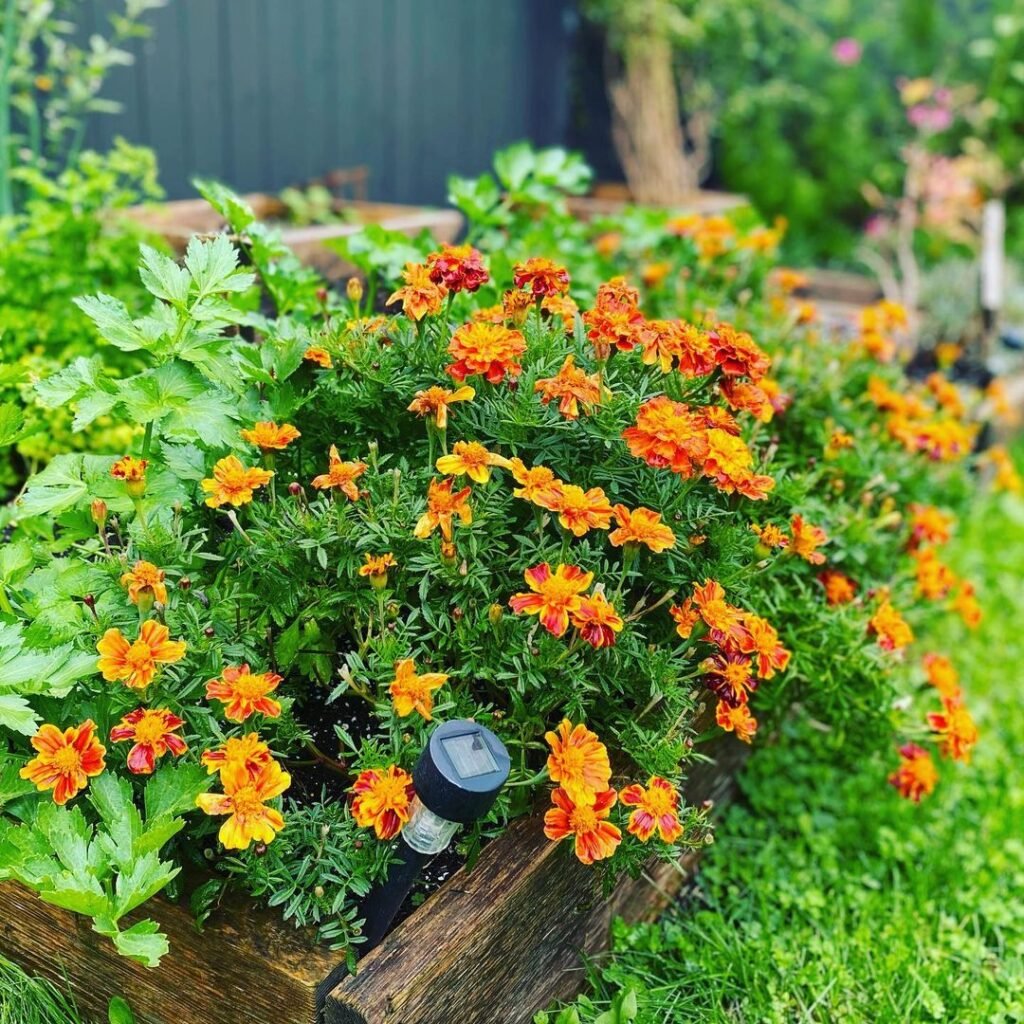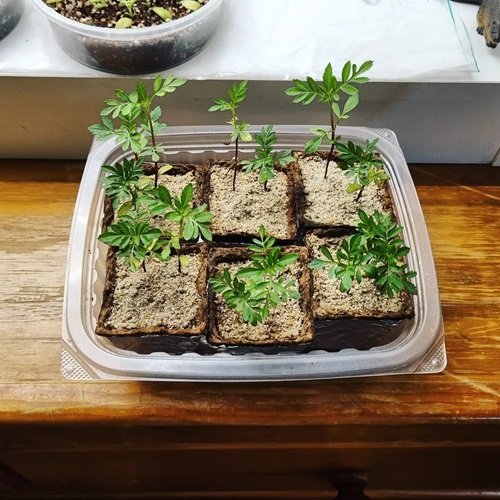Growing Marigolds is undoubtedly the best-known flower that grows very easily. These flowers appear in different colors, shapes, and sizes that lighten up any garden with its cheery flowers. The pest-repellent property of marigolds makes it a perfect plant to be included among other vegetable and herb plants. This is a complete guide on how to plant marigold seeds, beginning with choosing the type of your marigold, through sowing, maintaining, and harvesting. This guide helps how to Grow and look after your marigolds to get the brightest and most colorful flowers annually.
What You’ll Require :
Marigold seeds: You can buy marigold seeds online or from your local nursery. There are over 50 different Varieties of marigolds to choose from, such as African, French, or pot marigolds. Each marigold variety has different characteristics, such as height, color, and bloom time, so choose the ones that suit your preferences and your garden space.
Seed trays or pots: You can start your marigold seeds indoors or outdoors, depending on your climate and the time of the year. for indoors, you will need seed trays or pots with drainage holes, filled with good-quality potting soil. for outside, you will need a place in your garden that gets a lot of sun and where the water can drain well.
Watering can or hose: You will need to water your marigold seeds regularly to keep the soil moist but not soggy. A watering can or a hose with a gentle spray nozzle will help you water your seeds without disturbing them.
Fertilizer: Marigolds are not very fussy about fertilizer, but they will appreciate a boost of nutrients once they start growing. You can use a balanced organic fertilizer, such as compost, worm castings, or fish emulsion, to feed your marigolds every few weeks.
Pruning scissors: You will need to prune your marigolds occasionally to keep them healthy and productive. Pruning scissors will help you remove dead or diseased leaves and flowers, and encourage new growth and more blooms.
Check out Growing and Caring for Ranunculus Flowers
How to Grow Marigolds from Seeds

Marigolds are plants that like warm places. They do not grow well when it is cold The best suitable time to Plant your marigold flower seeds is in early spring when the soil temperature is above 15°C (60°F). You can Plant your seeds indoors or outdoors, depending on your preference and your climate.
Plant marigold seeds should be done approximately 6 to 8 weeks before the last frost date in your area for indoors. Put your potting soil in each of the seed trays or pots then sprinkle your seeds across them. Sprinkle sand on them and sprinkle some water on them. Choose a sunny place for your trays and pots like a windowsill or a greenhouse. Ensure constant moisture, yet without soggy or dried conditions; germination usually takes place between 7 and 14 days.
If you sow your seeds outdoors, you will need to do it after the last frost date in your area, when the soil is warm and workable. Choose an area that gets full sun in your garden with well-drained soil, and loosen the soil with a rake or a fork. Scatter your seeds on the surface, and rake them lightly into the soil. Make sure you water them plenty and keep the soil moist right until germination, which may take longer than indoors, depending on the weather.
Move the Marigold Seedlings

When your marigold seedlings have two or three pairs of true leaves, they are ready for transplanting or thinning. This will give them more space to grow and prevent overcrowding.
Indoors
For indoors, you will need to transplant your seedlings outdoors when the danger of frost has passed and the soil is warm. Harden off your seedlings by exposing them gradually to the outdoor conditions for a week or two, before planting them in their final location. Choose an area that gets full sun in your garden with well-drained soil, and dig holes that are twice as wide and deep as the root balls of your seedlings. Space of young plants about 20 to 30 cm (8 to 12 inches) between, Different varieties. Put your young plants in the holes, and cover them with dirt. Water very well, and put some natural stuff, like straw or leaves, around them to keep the water and stop the weeds
Outdoors
starting outdoors, you will need to thin your seedlings when they are about 10 cm (4 inches) tall. Remove the weakest or the smallest seedlings, and leave the strongest ones to grow. space of young plants about 20 to 30 cm (8 to 12 inches) between, depending on the variety. Water very well, and mulch them with organic matter, such as straw or leaves, to conserve moisture and prevent weeds.
Caring for marigold plants

Once they’re established, they are very easy to care for. marigold plants are drought-tolerant and they require minimal maintenance. These are some small tips to keep your marigold plants healthy and happy:
Water your marigold plants regularly, but take care of no overwatering. Water them deeply and infrequently, and let the soil dry out slightly between waterings. Water them at the base, and avoid wetting the foliage, to prevent fungal diseases.
Fertilize your marigold plants every few weeks, using a balanced organic fertilizer, such as compost, worm castings, or fish emulsion. Follow the instructions and do not overfeed your plants, as this may reduce their flowering and attract pests. which is not good for plant
Prune your marigold plants occasionally, using pruning scissors, to remove dead or diseased leaves and flowers, and to encourage new growth and more blooms. This will also improve the air circulation and the appearance of your plants.
Harvest marigold flowers when they are fully open, but before they start to fade. deadheading them in the morning, when they are fresh and dewy, and use a sharp knife or scissors to cut them at an angle, leaving some stem attached.
Check out Benefits of Companion Planting: A Guide for Gardeners
Benefits and Uses of Marigold Plants

Growing marigolds from seed is not only fun and easy but also rewarding and beneficial. there are some Medicinal Uses of Marigold Flowers
Skin Healing: Marigolds are highly valuable for medicinal purposes to have been for treating various skin conditions, such as rashes, allergies, eczema, and dermatitis. Marigold plants can help with healing cuts, lowering inflammation, and stopping infections because they have properties that fight against swelling, germs, and fungi.click here
Cramps And Indigestion: can use marigold flowers to give relief from cramps, spasms, and hemorrhoid pain. Calendula’s flowers have antispasmodic and anti-diarrheal effects that can help relieve stomach and intestinal disorders, such as indigestion,
Reduce Eye Inflammation: Calendula extract is effective and can help your eyes stay healthy and avoid infections. Marigold flowers have lutein and zeaxanthin, two substances that can keep your eyes safe from harmful light and stress. Marigold flowers can also protect your eyes less red and itchy if you have conjunctivitis
Pest-repellent: You can use marigold flowers to repel certain pests and attract beneficial insects in your garden. Marigold flowers can deter whiteflies, nematodes, and thrips from your plants, and also act as trap crops for other harmful insects. Marigold flowers can also attract bees, butterflies, and ladybugs, which can help pollinate your plants and eat other pests.
Growing Popular marigolds from seed is a great way to add annuals some color and charm to your garden. Marigolds are very easiest to grow from seed, and they require minimal care and maintenance. They are also beneficial for your garden and your health, as they repel pests and have medicinal uses. following these steps, you will be able to grow marigolds annually from seed successfully and enjoy their beauty and their benefits for a long time in your garden.
Pingback: Orange Flowers: 30 Best Flowers with Names and Pictures
Pingback: 30 Types of Sunflower Companion Plants -
Pingback: Hollyhocks: How to Grow and Care for These Classic Cottage Flowers -
Pingback: Grow Your Own Wisteria from Seeds: A Step-by-Step Guide -
Pingback: Demystifying June Bugs: Identification, Fascinating Facts, and Effective Control Methods for 2024 -
Pingback: Stop buying Avocado Learn how to grow it at home
Pingback: Floss Flower Planting and Growing Tips for Beginners
Pingback: Explore 20 Fascinating Flowers Beginning with F - Gardener's School
Pingback: Benefits of Companion Planting: A Guide for Gardeners
Pingback: Dealing with Tomato Hornworms: A Guide for Gardeners
Pingback: 49 Yellow Flowers Name & Specifications - Gardener's School
Pingback: Zodiac Flowers : A Blooming Guide to Your Astrological Floral Matches (2024)